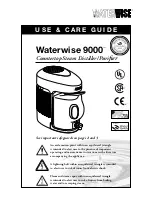
LX Series Unit Ventilator Controller User's Guide
11
The Optimum Start function maintains statistics that enable the Unit Ventilator
Controller to predict the warm-up or cool-down time period needed to make the
building ready for occupancy. The precise Optimum Start period is calculated
every day using the current outdoor air temperature.
L
ON
M
ARK
Functional Profile
The LX Series Unit Ventilator Controller uses L
ON
W
ORKS
network protocol and is
L
ON
M
ARK
certified for interoperability on any L
ON
W
ORKS
network. The Unit
Ventilator Controller is set up through its own configuration wizard and the Sensor
configuration wizard. You can use FX Workbench or any other network
management tool to install the device onto the network and bind variable
connections.
Figure 1 shows that the Unit Ventilator Controller meets the L
ON
M
ARK
standard
by providing the network variable inputs, network variable outputs, and
configuration properties specified by the profile. In addition, the Unit Ventilator
Controller provides many extra network variable inputs and outputs. These extra
network variables provide a greater flexibility and number of functions than
required in the L
ON
M
ARK
profile.
For example, you can use network input nviSlave, to slave the UVC to another
unit, whereas network output nvoUnitStatus, enables the UVC to act as the master
node. The Unit Ventilator Controller has network inputs that permit the use of
outside enthalpy sensors and space enthalpy sensors. These inputs provide better
calculation of the cooling or heating effect of the outside air upon the conditioned
space.
The input object has conversion tables and hardware properties present as
configuration properties in the area marked Manufacturer Configuration
Properties. By choosing from a list of standard thermistors, you can select different
conversion properties. The conversion tables configuration property allows you to
create your own custom tables. Hardware properties, located in the same area,
allow you to modify your input from the software object.












































